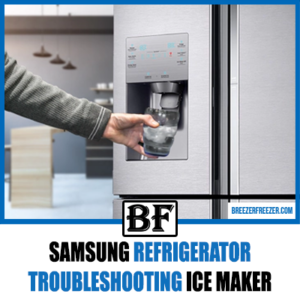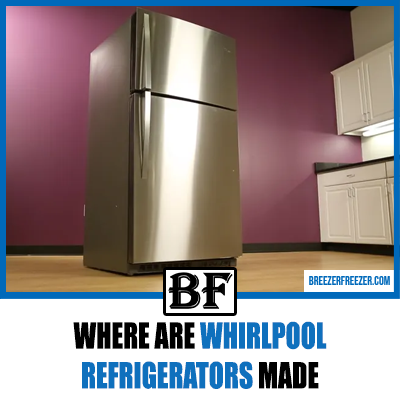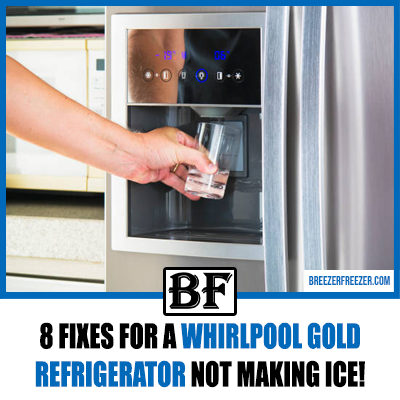Samsung Refrigerator Troubleshooting Ice Maker (Quick Fixes!)
When it comes to Samsung refrigerator ice makers, troubleshooting common issues can be done easily with the right guidance. Whether you own a Samsung French door or side-by-side fridge freezer, it’s important to know what to look for in order to address any problems.

Some of the common issues you may encounter with a Samsung ice maker include: no ice production, a non-functioning ice maker despite the dispenser working, ice maker freezing up, leaking, or failing to release ice.
You might also experience a slow or noisy ice maker, production of unpleasant-tasting or small ice cubes, an ice maker that won’t stop running, or an ice maker that doesn’t work after a period of rest.
The good news is that all nine of these ice maker issues can be resolved through do-it-yourself (DIY) fixes. This troubleshooting guide aims to provide you with the necessary information to address these problems. Keep in mind that most of these issues can have multiple causes, so I will do my best to cover all possible causes and provide relevant solutions.
Let’s get started with the troubleshooting process.
Quick Troubleshooting
| Problem | Possible Cause | Quick Fix |
| 1. The ice maker is not making ice | Ice maker is off, low water pressure, high freezer temperature, clogged filter or water line | Turn the ice maker on, raise water pressure to 20-120 psi, keep freezer temperature at 0-50°F, replace water filter, unblock water line |
| 2. The ice maker is working, but the water dispenser isn’t | High freezer temperature, blocked water line, low water pressure, faulty valve or motor | Adjust freezer temperature to 0-50°F, unblock water line, raise water pressure to 20-120 psi, replace faulty valve or motor |
| 3. Ice maker freezing up | Incorrect freezer temperature, frozen water line, paused ice maker, faulty valve or filter | Set freezer temperature at 0-50°F, unblock water line, unpause ice maker, replace faulty valve or water filter |
| 4. Leaky ice maker | Ice maker freezing up, not level, cracked ice bucket | Unfreeze ice maker, level it, replace cracked ice bucket |
| 5. The ice maker is not dumping ice | “Child Lock” engaged, low water pressure, water line blockage, faulty filter | Disengage “Child Lock,” raise water pressure, unblock water line, replace faulty filter |
| 6. Slow ice maker | Frozen water line, low pressure, high temperature, clogged filter | Unfreeze water line, raise water temperature, lower freezer temperature, replace clogged filter |
| 7. Noisy ice maker | Loose or faulty motor, lack of clearance | Fix loose motor, replace faulty motor, create enough clearance around the fridge |
| 8. The ice maker won’t stop | Sensor fault | Replace faulty sensor |
| 9. Dirty ice | Bad filter, contaminated supply line, broken ice bucket | Replace filter if older than six months, replace ice bucket if broken |
| 10. Ice tastes bad | Bad filter, contaminated supply line, broken ice bucket | Replace filter, report contaminated supply line to local authority, replace ice bucket |
| 11. The ice maker reset is not working | Wrong reset, blockage, “Child Lock,” low water pressure, high freezer temperature | Ensure correct reset, remove blockage, disengage “Child Lock,” adjust water pressure and freezer temperature as needed |
A Comprehensive Guide to Troubleshooting Samsung Refrigerator Ice Maker Issues
In this guide, we will address various problems that may arise with your Samsung refrigerator ice maker and provide quick fixes for each issue. Let’s examine the 11 common ice maker problems and discuss their potential causes and solutions:
Ice Maker Not Making Ice
If your Samsung ice maker is not producing ice, consider the following possibilities:
- Ice maker is turned off: Ensure that the ice maker is switched on by activating the ice icon or switch, depending on your Samsung model.
- Low water pressure: Adjust the water pressure to a range of 20-120 psi if it is too low.
- Freezer temperature is too high: Set the freezer temperature between 0-50°F.
- Clogged water filter or water line: Replace the water filter every six months and clear any obstructions or ice blockages in the water line. You can use a hair dryer to thaw a frozen water line.
Ice Maker Not Working But Water Does
If the water dispenser works fine but the ice maker is not functioning, consider these possibilities:
- High freezer temperature: Ensure that the freezer temperature remains below 100°F to prevent excessive warming and affect the ice maker’s operation.
- Blocked water line: Use a hair dryer to remove any ice blockages or kinks in the water line.
- Low water pressure: Improve the water pressure if it is below 20 psi, but do not exceed 120 psi.
- Faulty valve: Replace the water valve if it is older than six months or appears to be clogged with dirt.
- Faulty motor: If the motor makes noise or fails to spin, consider replacing it.
Ice Maker Freezing Up
If your Samsung ice maker frequently freezes up, consider the following causes:
- Incorrect freezer temperature: Maintain the freezer temperature within the range of 0-50°F.
- Frosted water line: Use a hair dryer to defrost any ice blocking the water line.
- Paused ice maker: Check if the ice maker is in a paused state and reactivate it.
- Clogged water filter or valve: Replace the water filter if it is older than six months, and clean the valve to remove any obstructions.
Ice Maker Leaking Water
Water leakage from the ice maker can be attributed to the following factors:
- Ice maker freezing up: Fluctuating temperatures can cause the ice maker to freeze and then thaw, resulting in leakage.
- Uneven refrigerator placement: Ensure that the refrigerator is positioned on a level surface to prevent leakage.
- Cracked ice bucket: Replace the damaged ice bucket to resolve water leakage.
Ice Maker Not Dumping Ice:
If the ice maker fails to dispense ice, consider the following possibilities:
- Child lock engaged: Deactivate the child lock feature to allow the ice maker to function properly.
- Water line blockage: Clear any blockages, including ice, from the water line.
- Low water pressure: Adjust the refrigerator’s water pressure to around 20 psi.
- Faulty filter: Replace the water filter if it is older than six months and causing low water pressure.
Slow Ice Maker
If your Samsung ice maker is slow in producing ice, consider these issues:
- Frozen water line: Inspect the water line for any frosting and defrost it using a hairdryer.
- Low water pressure: Measure the water pressure with a gauge and adjust it to a range of 20-120 psi if it is low.
- High freezer temperature: Ensure that the freezer temperature remains below 100°F.
- Clogged water filter: Replace the water filter if it is six months or older.
Noisy Ice Maker
If your Samsung ice maker is making excessive noise, consider the following factors:
- Faulty motor: Check if the motor is loose and tighten it. If the motor cannot spin properly, it should be replaced.
- Lack of clearance: Move your refrigerator away from the wall and ensure that there are no objects causing rattling when the refrigerator is running.
Ice Maker Won’t Stop Running
If your ice maker continuously produces ice and doesn’t stop, the likely culprit is a faulty sensor. The sensor should detect when the ice hopper is full and stop ice production. If the sensor fails to do so, the ice maker will continue running until it jams.
Fix: Replace the sensor if your ice maker won’t stop running.
Ice Maker Making Dirty Ice
Ideally, ice should have a cloudy white appearance. If it looks different, consider the following causes:
- Bad filter: Replace the water filter if it’s older than six months, as it may be clogged with dirt.
- Broken ice bucket: Replace the ice bucket if it is damaged.
- Contaminated supply line: Contact your local water authority if the water supply appears to be dirty.
Ice Tastes Bad
If the ice from your Samsung refrigerator has an unpleasant taste, consider these possibilities:
- Bad filter: Replace the water filter if it’s older than six months, as it may be contaminated with bacteria.
- Contaminated water supply: If the taste issue affects all household water, contact your local water supplier to address the problem.
Ice Maker Reset Not Working
If your Samsung ice maker fails to work after a reset, it may be due to incorrect resetting procedures. Follow these steps to properly reset your Samsung refrigerator ice maker:
- Remove the ice bucket to access the “Test” switch.
- Press and hold the switch until you hear a chime sound.
- Wait for approximately 6 minutes to allow the ice to fall into the ice bucket.
Other reasons why the ice maker may not work after a reset include blockages (check for drain clogging), activated child lock (deactivate if engaged), low water pressure (maintain water pressure at 20 psi or higher), and high freezer temperature (keep it within 0-50°F range).
Samsung French Door Ice Maker Problems
Common issues with Samsung French door ice makers include freezing up. To troubleshoot, set the freezer temperature to 0-50°F, defrost the frozen water line, and consider replacing faulty filters or water valves. If the ice maker is loud, tighten or replace the fan as necessary.
If the ice maker is not making ice, ensure it is turned on, improve water pressure to 20 psi or higher, unblock the water line, and reset the unit.
Samsung Side-by-Side Refrigerator Ice Maker Troubleshooting
The most common problems with Samsung side-by-side refrigerator ice makers include failure to make ice, failure to dispense ice, noisy operation, and water leakage. Troubleshoot these issues by ensuring the ice maker is turned on, adjusting water pressure (20-120 psi), replacing clogged filters, disengaging the child lock, and clearing any blockages.
Bottom Ice Maker Troubleshooting
The bottom ice maker in Samsung refrigerators faces similar issues to the French door unit, including freezing up, producing loud noise, getting stuck, not working at all, or producing dirty ice. Refer to the earlier table for quick fixes.
Conclusion
With the information provided in this guide, you now have the knowledge to identify and resolve common issues with your Samsung refrigerator ice maker. Before contacting a technician and incurring unnecessary expenses, it is recommended to try the suggested solutions outlined above. However, if you find the troubleshooting process challenging or are unable to resolve the problem on your own, don’t hesitate to seek assistance from a Samsung refrigerator expert.





